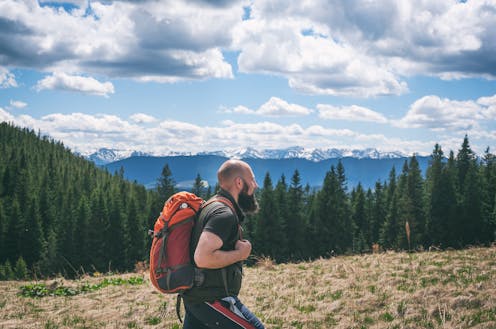What is minoxidil, the anti-balding hair growth treatment? Here’s what the science says
- Written by Jacinta L. Johnson, Senior Lecturer in Pharmacy Practice, University of South Australia

Hair loss (also known as alopecia) often affects the scalp but can occur anywhere on the body. It’s very common and usually nothing to worry about; about half of Australian men show signs of visible baldness at age 50 and over a quarter of Australian women report hair thinning by the same age. It’s often genetic.
But if you’ve noticed hair loss and are worried by it, see a GP or dermatologist for a diagnosis before trying any treatments. Products claiming to reverse hair loss are everywhere, but few have been scientifically tested for how well they work.
One group of products that have actually been scientifically tested, however, are known as topical minoxidil products. These include products such as Regaine®.
So, do they work? Here’s what the research evidence says, what you can realistically expect and what you need to know if you’re considering this treatment.
Read more: The art of balding: a brief history of hairless men
What is minoxidil – and does it work?
Topical minoxidil usually comes as a kind of foam or serum you apply to your scalp.
It’s been approved by the Therapeutic Goods Administration, Australia’s regulatory authority for therapeutic goods, for the treatment of hereditary hair loss in males and females. Minoxidil is also available in tablet form, but this isn’t currently approved for hair loss (more on that later).
So, is topical minoxidil effective? In short – yes, but the results vary widely from person to person, and it needs to be used consistently over several months to see results.
Scientists don’t know exactly how minoxidil works. It may affect the different phases of the hair life cycle, thereby encouraging growth. It also opens up blood vessels near hair follicles.
This increases blood flow, which in turn delivers more oxygen and nutrients to the hair.
While minoxidil is unlikely to restore a full head of thick, lush, hair, it can slow down hair loss and can stimulate regrowth.
It is the over-the-counter option with the most evidence. Two strengths are available: 5% and 2%.
An analysis of randomised controlled trials found minoxidil applied to the scalp twice a day increased the number of hairs per square centimetre by eight to 15 hairs, with the higher strength treatment having a slightly greater effect.
Can I use it for non-genetic balding?
There are many causes of hair loss. The main cause in both males and females is a hereditary condition called androgenic alopecia.
Although topical minoxidil is only approved for use in Australia for androgenic alopecia, there is some evidence it can also help in other conditions that cause hair loss.
For example, it may hasten hair regrowth in patients who have lost hair due to chemotherapy.
Unfortunately, minoxidil is not effective when the hair follicle is gone, like after a burn injury.
Although small studies have found promising results using minoxidil to promote hair growth on the face (for beard or eyebrow enhancement), topical minoxidil products are not currently approved for this use. More research is required.
What else do I need to know?
Minoxidil won’t work well for everyone. Early in treatment you might notice a temporary increase in hair shedding, as it alters the hair cycle to make way for new growth. Minoxidil needs to be trialled for three to six months to determine if it’s effective.
And as it doesn’t cure hair loss, you must continue to use it each day to maintain the effect. If you stop, you will start losing the new hair growth within three to four months.
Minoxidil products may not be suitable for everyone. If you have any medical conditions or take any medications, you should speak with your doctor or pharmacist before using minoxidil products.
It has not been tested for safety in people under 18, over 65, or those who are pregnant.
You can read the consumer medicines information sheet for more information about using over-the-counter minoxidil products.
Many people do not like to use minoxidil solution or foams long-term because they need to be applied everyday day, which can be inconvenient. Or they may notice side effects, such as scalp irritation and changes to hair texture.
Some people tolerate the foam products better than the solution, as the solution contains more of a compound called propylene glycol (which can irritate the skin).
What about the oral tablet form of minoxidil?
Minoxidil is also available on prescription as an oral tablet. While traditionally used for high blood pressure, it has also been used as a treatment for hair loss.
In 2020, a systematic review identified 17 studies involving 634 patients using oral minoxidil for various hair loss conditions.
The authors found oral minoxidil was effective and generally well tolerated in healthy people who were having trouble using the topical products.
The review noted oral minoxidil may increase hair growth over the whole body and may cause heart-related side effects in some patients. More research is required.
In Australia, oral minoxidil is available under the trade name Loniten®. However, it is currently only approved for use in high blood pressure.
When people seek a prescription treatment for a non-approved purpose, this is called “off-label” prescribing. Off-label prescribing of oral minoxidil, potentially for use in alopecia, may have contributed to shortages of Loniten® tablets in recent years. This can reduce availability of this medicine for people who need it for high blood pressure.
Read more: Big hair? Bald? How much difference your hair really makes to keep you cool or warm
Authors: Jacinta L. Johnson, Senior Lecturer in Pharmacy Practice, University of South Australia



